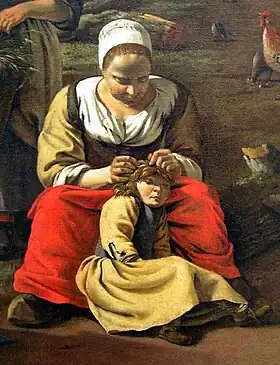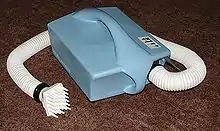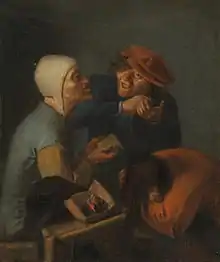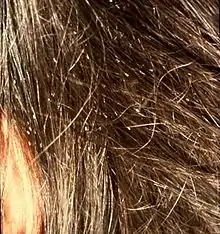Treatment of human lice
The treatment of human lice is the removal of head lice parasites from human hair. It has been debated and studied for centuries. However, the number of cases of human louse infestations (or pediculosis) has increased worldwide since the mid-1960s, reaching hundreds of millions annually.[1] There is no product or method that assures 100% destruction of the eggs and hatched lice after a single treatment. However, there are a number of treatment modalities that can be employed with varying degrees of success. These methods include chemical treatments, natural products, combs, shaving, hot air, and silicone-based lotions.
| Treatment of human lice | |
|---|---|
 Mother hunting for headlice, detail of a painting by Jan Siberechts | |
| Specialty | infectious disease |
Treatment is recommended only after a clear diagnosis since all treatments have potential side effects.[2] Louse eggs hatch 6–9 days after oviposition. Therefore, a common recommendation is to repeat treatment with a pediculicide at least once after 10 days, when all lice have hatched.[3] Between the two treatments (Days 2–9) the person will still be infested with lice that hatch from eggs not killed by the anti-louse product. Between the treatments, it is advised to wet the hair and comb daily with a louse-comb to remove the hatching lice. If no living lice are found, the treatment was successful, even if nits (eggs) are visible on the hair. If living lice are still present, the treatment is repeated using an anti-louse product with a different active ingredient. This is kept in the hair for 2 hours and then rinsed out, with the head and hair cleaned before sleep. Prophylactic treatment with pediculicides is not recommended.[4]
Medications
Insecticides used for the treatment of head lice include lindane, malathion, carbaryl, pyrethrum, piperonyl butoxide, permethrin, phenothrin, bioallethrin, and spinosad.
Many of the pediculicides in the market are either not fully effective or are ineffective when they are used according to the instructions.[5][6][7][8] Pediculicides may rapidly lose their efficacy because of the development of resistance. Resistance of head lice to insecticides such as lindane, malathion, phenothrin and permethrin has been reported.[9][10][11]
A 2021 systematic review and meta-analysis found that the mean frequency of pyrethroid resistance of lice was 77% globally, and even 100% in several countries (Australia, England, Israel, and Turkey).[12] It concluded that treatment with current insecticides may not be effective and is likely the cause of increased levels of infestations.[12]
Ivermectin by mouth has been shown to reduce levels of louse infestation.[13][14][15] Ivermectin is approved by the U.S. Food and Drug Administration (FDA) for pediculosis.[16]
Agents approved by the FDA for treatment of pediculosis include abametapir,[17] topical ivermectin lotion, lindane, malathion, permethrin, and piperonyl butoxide with pyrethrins.[18]
Heated air

A standard home blow dryer will kill 96.7% of eggs with proper technique.[19] To be effective, the blow dryer must be used repeatedly (every 1 to 7 days since eggs hatch in 7 to 10 days) until the natural life cycle of the lice is over (about 4 weeks).[20]
A number of commercial head lice treatment companies across the country offer a heated air treatment.
Combing

A special fine-toothed comb that can pick out lice is used. For a treatment with louse comb alone, it is recommended to comb the hair for an hour to an hour and a half (depending the length and type of the hair) daily or every second day for 14 days. Wetting the hair especially with water and shampoo or conditioner will facilitate the combing and the removal of lice, eggs and nits.[21][22][23][24]
Electronic louse combs use a small electrical charge to kill lice. The metal teeth of the comb have alternating positively and negatively charged tines, which are powered by a small battery. When the comb is used on dry hair, lice make contact with multiple tines of the fine-toothed comb, thereby closing the circuit and receiving an electrical charge. A non-peer-reviewed letter has been published in a dermatology journal claiming effectiveness based on personal experience (total of 6 uses).[25]
Procedures
Shaving the head or cutting the hair extremely short can be used to control lice infestation. Short hair, baldness, or a shaven scalp are generally seen as a preventive measure against louse infestation. This will also eliminate – particularly if maintained for the length of the parasites' reproductive cycle – louse infestation.
Infestation with lice is not a serious disease and the medical symptoms are normally minimal. In any case, health providers and parents should try not to create emotional problems for children during examination and treatment.[26]
Shaving of the area above and behind the ears and the upper part of the neck while leaving the crown of the head with hair is commonly used to prevent lice among tribes in Africa, Asia, and America (in America – Mohawk style).
School treatment

Schools in the United States, Canada, and Australia commonly exclude infested students, and prevent return of those students until all lice, eggs, and nits are removed.[27] This is the basis of the "no-nit policy". Data from a primarily American study during 1998–1999 found that no-nit policies were present at 82% of the schools attended by children suspected of louse infestation.[28] A separate 1998 survey revealed that 60% of American school nurses felt that "forced absenteeism of any child who has any nits in their hair is a good idea."[29]
A number of health researchers and organizations object to the no-nit policy.[27][30][31][32] Opponents to the no-nit policy mention that visible nits may only be empty egg casings which pose no concern as transmission can only occur via live lice or eggs.[27] This has led to the perception that the no-nit policy serves only to ease the workload of school nurses and punish the parents of infested children.[27]
Proponents of the no-nit policy counter that only a consistently nit-free child can be reliably shown to be infestation-free.[33] That is, the presence of nits serves as an indirect proxy for infestation status. Proponents argue that such a proxy is necessary because lice screening is prone to false negative conclusions (i.e., failure to find lice present on actively infested children).[30][34] For example, a 1998 Israeli study found that 76% of live lice infestations were missed by visual inspection (as verified by subsequent combing methods).[35][36] Although lice cannot fly or jump, they are fast and agile in their native environment (i.e., clinging to hairs near the warmth of the scalp),[30] and will try to avoid the light used during inspection.[37][38] Louse colonies are also sparse (often fewer than 10 lice), which can contribute to difficulty in finding live specimens.[39] Further, lice populations consist predominantly of immature nymphs,[40] which are even smaller and harder to detect than adult lice.[35]
Alternative medicine
Tea tree oil has been promoted as a treatment for head lice; however, evidence of its effectiveness is weak.[41][42] A 2012 review of head lice treatment recommended against the use of tea tree oil for children because it could cause skin irritation or allergic reactions, because of contraindications, and because of a lack of knowledge about the oil's safety and effectiveness.[43] Other home remedies such as putting vinegar, isopropyl alcohol, olive oil, mayonnaise, or melted butter in the hair have been partially disproven,[44] The use of plastic bags may be dangerous.[45] Similarly, the Centers for Disease Control and Prevention reports that swimming has no effect on treating lice, and can in fact harm the treatment by commercial products.[46] Ethanol (ethyl alcohol, common alcohol) is toxic to arthropods including lice and an external application of it is harmless to humans.[47]
Gasoline or kerosene
The use of kerosene or gasoline for prevention or treatment of lice is dangerous due to the inherent fire hazard.[4][48] Since 1989, there have been at least nine cases of children being severely burned during such attempts. These cases apparently occurred because, contrary to popular belief, it is the fumes of the gasoline, rather than the liquid itself, that are flammable. These fumes can ignite due to the presence of even a small spark or open flame - such as those caused by electrical appliances, cigarette lighters, or pilot lights in stoves and water heaters. The use of gasoline to treat lice also carries a high risk of dermatitis (i.e. irritation of the scalp).[49]
Before gasoline (Petrol) was used as fuel, it was sold in small bottles as a treatment against lice and their eggs. At that time, the word Petrol was a trade name.[50]
References
- Gratz, N. (1998), Human lice, their prevalence and resistance to insecticides (PDF), Geneva: World Health Organization (WHO), retrieved 20 April 2020
- Frankowski, BL; Bocchini, JA Jr; American Academy of Pediatrics. Council on School Health and Committee on Infectious Diseases. (August 2010). "Head Lice (October 1, 2010 Clinical Report)". Pediatrics. 126 (2): 392–403. doi:10.1542/peds.2010-1308. PMID 20660553.
- Mumcuoglu, Kosta (May 2006). "Effective Treatment of Head Louse with Pediculicides". Journal of Drugs in Dermatology. 5 (5): 451–452. PMID 16703782.
{{cite journal}}: CS1 maint: date and year (link)
- Mumcuoglu, Kosta Y.; Barker, CS; Burgess, IF; Combescot-Lang, C; Dagleish, RC; Larsen, KS; Miller, J; Roberts, RJ; Taylan-Ozkan, A. (2007). "International Guidelines for Effective Control of Head Louse Infestations". Journal of Drugs in Dermatology. 6 (4): 409–414. PMID 17668538.

- Roberts, RJ; Casey D; Morgan DA; Petrovic M (12 August 2000). "Comparison of Wet Combing With Malathion for Treatment of Head Lice in the UK: A Pragmatic Randomised Controlled Trial". The Lancet. Amsterdam: Elsevier. 356 (9229): 540–544. doi:10.1016/S0140-6736(00)02578-2. PMID 10950230. S2CID 9790264.
- Mumcuoglu, KY; Miller, J. (1991). "The Efficacy of Pediculicides in Israel". Israel Journal of Medical Sciences. Jerusalem: Weizmann Science Press. 27 (10): 562–565. PMID 1955310.
- Vander Stichele, Robert H; Dezeure Els M; Bogaert Marc G. (2 September 1999). "Systematic Review of Clinical Efficacy of Topical Treatments for Head Lice". British Medical Journal. London: BMJ Publishing Group Ltd. 311 (7005): 604–608. doi:10.1136/bmj.311.7005.604. PMC 2550649. PMID 7545045.
- Meinking, Terri L.; Entzel, Pamela; Villar, Maria Elena; Vicaria, Maureen; Lemard, Glendene A; Porcelain, Sherri L. (March 2001). "Comparative Efficacy of Treatments for Pediculosis Capitis Infestations". Archives of Dermatology. Chicago: American Medical Association. 137 (3): 287–292. PMID 11255326. Retrieved 2008-01-03.
- Pollack RJ, Kiszewski A, Armstrong P, Hahn C, Wolfe N, Rahman HA, Laserson K, Telford SR, Spielman A (September 1999). "Differential Permethrin Susceptibility of Head Lice Sampled in the United States and Borneo". Archives of Pediatrics & Adolescent Medicine. Chicago: American Medical Association. 153 (9): 969–973. doi:10.1001/archpedi.153.9.969. PMID 10482215.
- Burkhart, Craig G. (May 2004). "Relationship of Treatment-Resistant Head Lice to the Safety and Efficacy of Pediculicides". Mayo Clinic Proceedings. Rochester, Minnesota: Mayo Clinic. 79 (5): 661–666. doi:10.4065/79.5.661. PMID 15132409. Archived from the original (PDF) on 2006-10-31. Retrieved 2008-01-03.
- Yoon, Kyong Sup; Gao, Jian-Rong; Lee, Si Hyeock; Clark, J. Marshall; Brown, Leon; Taplin, David (August 2003). "Permethrin-Resistant Human Head Lice, Pediculus capitis, and Their Treatment". Archives of Dermatology. Chicago: American Medical Association. 139 (8): 994–1000. doi:10.1001/archderm.139.8.994. PMID 12925385.
- Mohammadi, Jalal; Azizi, Kourosh; Alipour, Hamzeh; Kalantari, Mohsen; Bagheri, Masoumeh; Shahriari-Namadi, Marzieh; Ebrahimi, Saeedeh; Moemenbellah-Fard, Mohammad D. (2021). "Frequency of pyrethroid resistance in human head louse treatment: systematic review and meta-analysis". Parasite. 28: 86. doi:10.1051/parasite/2021083. PMC 8693761. PMID 34935614.

- Chosidow O, Giraudeau B, Cottrell J, et al. (March 2010). "Oral ivermectin versus malathion lotion for difficult-to-treat head lice". N. Engl. J. Med. 362 (10): 896–905. doi:10.1056/NEJMoa0905471. PMID 20220184.
- Munirathinam A, Sunish IP, Rajendran R, Tyagi BK (November 2009). "Impact of ivermectin drug combinations on Pediculus humanus capitis infestation in primary schoolchildren of south Indian rural villages". Int. J. Dermatol. 48 (11): 1201–5. doi:10.1111/j.1365-4632.2008.04059.x. PMID 20064176. S2CID 33425444.
- Foucault C, Ranque S, Badiaga S, Rovery C, Raoult D, Brouqui P (February 2006). "Oral ivermectin in the treatment of body lice". J. Infect. Dis. 193 (3): 474–6. doi:10.1086/499279. PMID 16388498.
- http://www.accessdata.fda.gov/drugsatfda_docs/label/2012/202736s000lbl.pdf
- "Drug Trial Snapshot: Xeglyze". U.S. Food and Drug Administration (FDA). 24 July 2020. Retrieved 6 August 2020.
- Amy J. McMichael; Maria K. Hordinsky (2008). Hair and Scalp Diseases: Medical, Surgical, and Cosmetic Treatments. Informa Health Care. pp. 289–. ISBN 978-1-57444-822-1. Retrieved 27 April 2010.
- Goates, Brad M.; Atkin, Joseph S.; Wilding, Kevin G.; Birch, Kurtis G.; Cottam, Michael R.; Bush, Sarah E.; Clayton, Dale H. (5 November 2006). "An Effective Nonchemical Treatment for Head Lice: A Lot of Hot Air" (PDF). Pediatrics. 118 (5): 1962–1970. doi:10.1542/peds.2005-1847. PMID 17079567. S2CID 9482708. Archived from the original (PDF) on 11 October 2010. Retrieved 2010-08-01.
- "Hot air for head lice". Archives of Disease in Childhood. 92 (3): 241. 2007-03-01. doi:10.1136/adc.2006.113431. PMC 2083419.
- Abdel-Ghaffar, Fathy; Semmler, Margit (10 August 2006). "Efficacy of Neem Seed Extract Shampoo on Head Lice of Naturally Infected Humans in Egypt". Parasitology Research. 100 (2): 329–332. doi:10.1007/s00436-006-0264-2. PMID 16900389. S2CID 1826025.
- Mumcuoglu, Kosta Y. (July–September 1999). "Prevention and Treatment of Head Lice in Children". Paediatric Drugs. 1 (3): 211–218. doi:10.2165/00128072-199901030-00005. PMID 10937452. S2CID 13547569.
- Bingham, P; Kirk, S; Hill, N; Figueroa, J (2000). "The methodology and operation of a pilot randomized control trial of the effectiveness of the bug busting method against a single application insecticide product for head louse treatment". Public Health. 114 (4): 265–268. doi:10.1038/sj.ph.1900645. PMID 10962588.
- Plastow, Liz; Luthra, Manjo; Powell, Roy; Wright, Judith; Russell, David; Marshall, Martin (April 2001). "Head lice infestation: bug busting vs. traditional treatment". Journal of Clinical Nursing. 10 (6): 775–783. doi:10.1111/j.1365-2702.2001.00541.x. PMID 11822849.
- Resnik, Kenneth (February 2005). "A non-chemical therapeutic modality for head lice". Journal of the American Academy of Dermatology. 52 (2): 374. doi:10.1016/j.jaad.2004.07.032. PMID 15692498.
- Mumcuoglu, Kosta Y. (1991). "Head Lice in Drawings of Kindergarten Children". The Israel Journal of Psychiatry and Related Sciences. 28 (1): 25–32. PMID 1860777.
- Mumcuoglu, Kosta Y.; Meinking, Terri A; Burkhart, Craig N; Burkhart, Craig G. (2006). "Head Louse Infestations: The "No Nit" Policy and Its Consequences". International Journal of Dermatology. 45 (8): 891–896. doi:10.1111/j.1365-4632.2006.02827.x. PMID 16911370. S2CID 38910169.
- Pollack RJ, Kiszewski AE, Spielman A (2000). "Overdiagnosis and consequent mismanagement of head louse infestations in North America". The Pediatric Infectious Disease Journal. 19 (8): 689–93. doi:10.1097/00006454-200008000-00003. PMID 10959734. S2CID 2557006.
- Price JH, Burkhart CN, Burkhart CG, Islam R (April 1999). "School nurses' perceptions of and experiences with head lice". The Journal of School Health. 69 (4): 153–8. doi:10.1111/j.1746-1561.1999.tb04174.x. PMID 10354985.
- Frankowski, Barbara L.; Leonard B. Weiner; the Committee on School Health; the Committee on Infectious Diseases (September 2002). "Head Lice: American Academy of Pediatrics Clinical Report". Pediatrics. 110 (3): 638–643. doi:10.1542/peds.110.3.638. ISSN 0031-4005. PMID 12205271. S2CID 245074002. Archived from the original on 2008-10-13. Retrieved 2008-10-10.
- Frankowski, Barbara L. (September 2004). "American Academy of Pediatrics guidelines for the prevention and treatment of head lice infestation". The American Journal of Managed Care. 10 (9): S269–S272. PMID 15515631. Retrieved 2008-10-10.
- National Association of School Nurses (July 2004). "Pediculosis in the School Community: Position Statement". Silver Spring, Maryland: National Association of School Nurses. Retrieved 2008-10-10.
- "The No Nit Policy: A Healthy Standard for Children and their Families". The National Pediculosis Association. 2008. Retrieved 2008-10-12.
- National Health and Medical Research Council (December 2005). Staying Healthy in Child Care: Preventing infectious diseases in child care (4th ed.). Commonwealth of Australia. ISBN 978-0-642-45631-1.
- Mumcuoglu KY, Friger M, Ioffe-Uspensky I, Ben-Ishai F, Miller J (2001). "Louse comb versus direct visual examination for the diagnosis of head louse infestations". Pediatric Dermatology. 18 (1): 9–12. doi:10.1046/j.1525-1470.2001.018001009.x. PMID 11207962. S2CID 27464495.
- Hootman J (April 2002). "Quality improvement projects related to pediculosis management". The Journal of School Nursing. 18 (2): 80–6. doi:10.1177/10598405020180020401. PMID 12017250. S2CID 29291526.
- Bacot A (1917). "Contributions to the bionomics of Pediculus humanus (vestimenti) and Pediculus capitis". Parasitology. 9 (2): 228–258. doi:10.1017/S0031182000006065. S2CID 86846228.
- Nuttall, George H. F. (1919). "The biology of Pediculus humanus, Supplementary notes". Parasitology. 11 (2): 201–221. doi:10.1017/S0031182000004194. S2CID 251061971.
- Mumcuoglu KY, Miller J, Gofin R, et al. (September 1990). "Epidemiological studies on head lice infestation in Israel. I. Parasitological examination of children". International Journal of Dermatology. 29 (7): 502–6. doi:10.1111/j.1365-4362.1990.tb04845.x. PMID 2228380. S2CID 39798857.
- Buxton, Patrick A. (1947). "The biology of Pediculus humanus". The Louse; an account of the lice which infest man, their medical importance and control (2nd ed.). London: Edward Arnold. pp. 24–72.
- Jacobi, Tillmann (22 September 2011). "The Basics – The management of head lice". GP: 38.
All in all, the evidence for alternative treatments, such as tea tree oil and neem seed oil, remains weak.
- "Tea tree oil". Medline Plus, a service of the U.S. National Library of Medicine from the National Institutes of Health. 27 July 2012.
- Eisenhower, Christine; Farrington, Elizabeth Anne (2012). "Advancements in the Treatment of Head Lice in Pediatrics". Journal of Pediatric Health Care. 26 (6): 451–61, quiz 462–4. doi:10.1016/j.pedhc.2012.05.004. PMID 23099312.
- Takano-Lee, Miwa; Edman, John D.; Mullens, Bradley A.; Clark, John M. (December 2004). "Elsevier". Journal of Pediatric Nursing: Nursing Care of Children and Families. Pediatricnursing.org. 19 (6): 393–398. doi:10.1016/j.pedn.2004.11.002. PMID 15637580. Retrieved 2012-11-22.
- "Massachusetts toddler dies after lice treatment goes awry". Yahoo News/Reuters. February 5, 2015.
- "CDC – Frequently Asked Questions – Healthy Swimming & Recreational Water – Healthy Water". Cdc.gov. 2012-10-22. Retrieved 2012-11-22.
- JF Marriott. 2010. Pharmaceutical Compounding and Dispensing. p.77: https://books.google.com/books?id=J5vE3Z_ZXJcC&q=lice&pg=PA77 p.77:"ALCOHOL. After water, this is probably the next most important solvent used pharmaceutically. Although ethanol (ethyl alcohol) is rarely used as a lone solvent for preparations for internal use, it is used in the manufacture of some of the galenicals used in pharmacy (e.g. tinctures, see Chapter 2). In extemporaneous dispensing it is normally used for the production of lotions for external application to unbroken skin. It is particularly useful if rapid evaporation is required (e.g. for insecticidal lotions applied to hair for the treatment of lice)..."
Ethanol as an arthropod killing solution, e.g. Szinwelski, N., Fialho, V. S., Yotoko, K. S. C., Seleme, L. R., & Sperber, C. F. (2012). Ethanol fuel improves arthropod capture in pitfall traps and preserves DNA. ZooKeys, (196), 11–22. Advance online publication. http://doi.org/10.3897/zookeys.196.3130 "...It has been shown that at concentrations higher than 95%, commercial alcohol preserves DNA (Nagy 2010), but the use of highly concentrated commercial alcohol as a killing solution may be prohibitively expensive when needed in large quantities, such as in large-scale biodiversity sampling. In Brazil, for example, it is illegal to carry large amounts of commercial alcohol on long journeys, which could hinder its use in extensive field expeditions. Here we propose the use of ethanol fuel as a cheaper and logistically feasible alternative..."
Sociedad Argentina de Pediatria. Actualización en pediculosis. http://sap.org.ar/docs/publicaciones/pediculosis.pdf: "La cuasia amarga (palo amargo) se extrae de un arbusto que crece en el norte de la Argentina. El principio activo que se extrae de la madera es la cuasina y químicamente es un hidrocarburo soluble en alcohol. Popularmente se lo usa como repelente de piojos y como pediculicida. Es efectiva únicamente en solución alcohólica y no en solución acuosa. Así es tan efectiva como una solución pura de alcohol por lo cual se duda de su efecto pediculicida “per sé” y es irritativa." - "Indiana Teenager Critically Burned Trying to Kill Head Lice". FOX News. February 26, 2009.
- Gasoline Lice Treatment at snopes.com.
- "History of Carless, Capel & Leonard". Vintage Garage. 2008. Archived from the original on 2014-12-29. Retrieved 2014-12-28.
Further reading
- "Head lice and nits – Treatment". NHS Choices. 17 May 2016. Retrieved 31 August 2016.